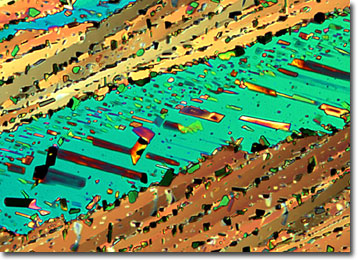Polarized Light Microscopy Digital Image Gallery
Vitamin B6
Vitamin B6, an essential nutrient for animals and microorganisms, occurs in three different varieties: pyridoxine, pyridoxamine, and pyridoxal. Though each of these members of the vitamin B6 group features a slightly different chemical structure, they all combine with phosphorous inside of the body to form the active coenzyme pyridoxal phosphate.

View a second image of Vitamin B6
In 1938, pyridoxine became the first form of vitamin B6 to be isolated, and the following year it was the first to be synthesized in a laboratory. It was not until the 1940s that pyridoxal and pyridoxamine were discovered, although they contribute more to bodily vitamin B6 activity than does pyridoxine. The function of the B6 vitamins in their coenzyme form is only vaguely understood, but is, nevertheless, very important. The substance plays a role in the ability of living tissues to form and breakdown amino acids, and is involved in the synthesis of various substances, such as the neurotransmitters norepinephrine and serotonin, as well as heme, a ferrous component of hemoglobin.
Vitamin B6 is found in a wide variety of foods, including meats, corn, nuts, soybeans, wheat germ, oats, and molasses. Exposure to sunlight or heat can, however, decrease the natural levels of the vitamin in these items. The United States Food and Drug Administrationís Recommended Dietary Allowance (RDA) of the vitamin is 2 milligrams, but the effects of consuming inadequate amounts of it are rather non-specific, dependent on other factors in the diet, and difficult to reproduce. In experiments with infants, however, vitamin B6 deficiency has been shown to produce central nervous system problems, such as convulsions that can be quickly ceased when the vitamin is dispensed to the child.
